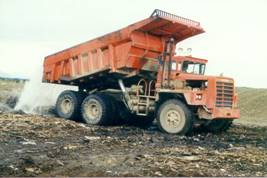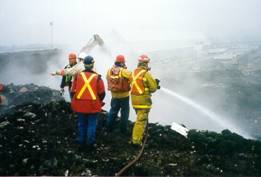|
UNDERSTANDING AND
CONTROLLING LANDFILL FIRES
Extinguishment Methods
Water Application:
Water
is an effective fire fighting agent, but only if it can reach
the burn zone in large quantities. 0.18 GJ of energy are
consumed in raising one m3 of water from 55°C
to 100°C.
A further 2.25 GJ of energy are consumed in the phase change from
liquid to vapour. From an energy balance perspective, three
or four m3 of water are required to absorb the thermal
energy released by the combustion of one tonne of burning refuse.
In practice, somewhat less water is required since the rate of
energy release in an underground fire is slow; nevertheless, as
a rule of thumb 0.5 to 1.0 m3 of water is required
for each m3 waste that is involved in the fire.
During
the recent Vancouver Landfill DLC fire in October, 2000 three
large earth moving trucks were utilized to deliver 20 m3
(5,000 gallon) payloads of fire fighting water to the burn zone.
Photo 5 shows one of the Mack trucks delivering it’s payload.
An agricultural water cannon capable of delivering a steady stream
of 250 L/minute (60 GPM) was brought on line near the end of the
fire fight. In total, 4,300 m3 of water were
applied over seven days to extinguish the fire involving approximately
4,000 m3 of burning DLC. As a result of the very
high permeability of DLC waste, the entire payload penetrated
the DLC waste in seconds each time a truck was unloaded.
In this case, water application was successful because the DLC
landfill was only 8 m high and no intermediate cover layers were
present to prevent penetration of the water to depth.


PHOTO 5. MACK TRUCK WITH 20 000L PAYLOAD Photo
6.
LIGHT MIST APPLICATION 30GPM
At
the Delta Shake and Shingle DLC Fire (November 1999 – April 2000),
over 250,000 m3 of DLC was ultimately involved in the
fire. Since the waste was piled up to 20 m high and the
fire was burning intensely at depth, extinguishment by application
of water was not effective. Application of water from monitors
capable of delivering 360 L/min (90 GPM) was throttled back to
120 L/min m3 per minute (30 GPM) to apply the water
as a dispersed wetting mist rather than a concentrated stream
(see Photo 6). This method of application proved more effective
in controlling open flame at surface.

     next page
next page  continue with Extinguishment Methods
continue with Extinguishment Methods
|

